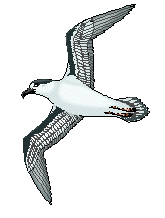Please Help Pets by Donating One Dollar
Storm Petrels and Diving Petrels
Petrels are also called Gadifly Petrels. Their flight is very fast
closely resembling Shearwaters.
Petrels is the common name for members of three families of seabirds:
the storm petrels (Hydrobatidae), the diving petrels (Pelecanoididae),
and members of a family (Procellariidae) that also includes the fulmars
and shearwaters.
Most petrels breed in colonies on islands in the southern hemisphere.
They are powerful fliers with long wings. Their bills are hooked, with
close-set, tubular nostrils.
Petrels vary in size from the storm petrel, of which the smallest
species is 5.5 inches long, to the two giant petrels, which range
up to 36 inches in length and are larger than some albatrosses.
Most petrels breed in colonies on islands in the southern hemisphere.
A few of the gadfly petrels breed farther north on islands such as
Madeira, Bermuda, the West Indies, and the Hawaiian Islands.
Petrels wander widely at sea during the non breeding season. They
are powerful fliers with long wings. Their bills are strongly hooked,
and their tubular nostrils are set close together along the top
of the bill
They eat fish and shrimp. Nesting is in burrows. They lay 1 egg.
Petrels belong to the order Procellariiformes
The storm petrels make up the family Hydrobatidae and the diving
petrels the family Pelecanoididae. The remaining petrels, as well as
the fulmars and shearwaters, belong to the family Procellariidae
Picture Petrel

Types of Petrels:
Black-capped Petrel
Mottled Petrel
Storm Petrels flutter and hop over waves, pattering with webbed feet.
They are found singly or in flocks. Storm Petrels lay 1 egg.
Types of Storm Petrels:
Ashy Storm Petrel
Band-rumped Storm Petrel
Black Storm Petrel
Fork-tailed Storm Petrel
Leach's Storm Petrel
Least Storm Petrel
Wilson's Storm Petrel
Index of North American Birds